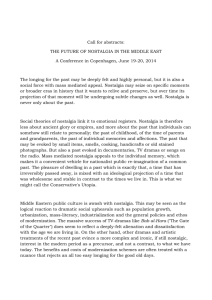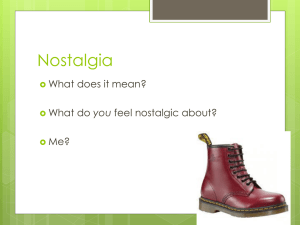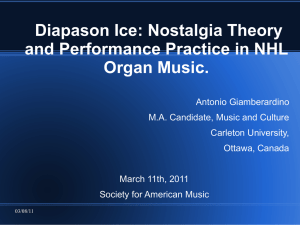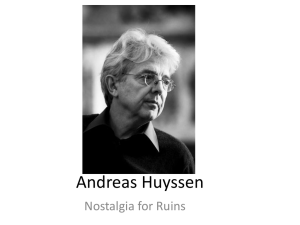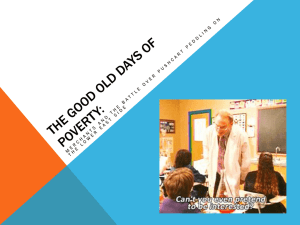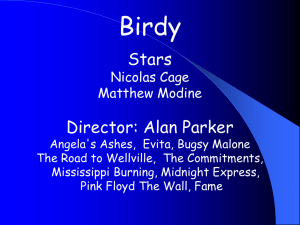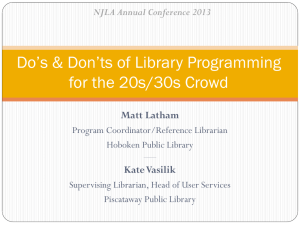NOSTALGIA AND MEANING - ePrints Soton
advertisement
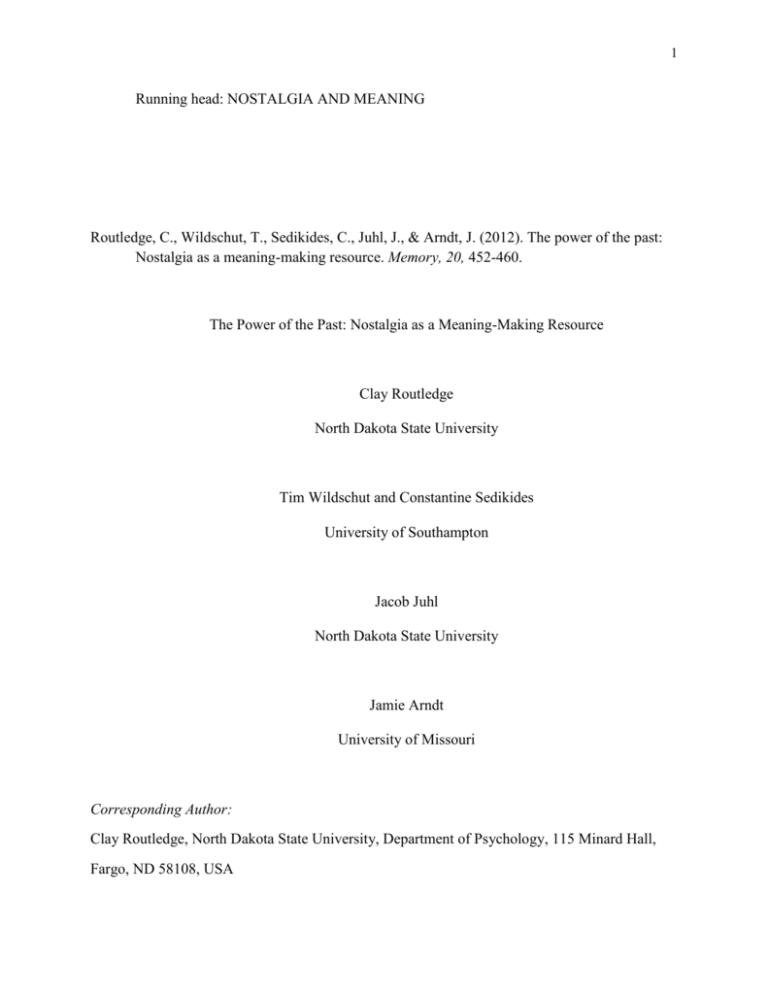
1 Running head: NOSTALGIA AND MEANING Routledge, C., Wildschut, T., Sedikides, C., Juhl, J., & Arndt, J. (2012). The power of the past: Nostalgia as a meaning-making resource. Memory, 20, 452-460. The Power of the Past: Nostalgia as a Meaning-Making Resource Clay Routledge North Dakota State University Tim Wildschut and Constantine Sedikides University of Southampton Jacob Juhl North Dakota State University Jamie Arndt University of Missouri Corresponding Author: Clay Routledge, North Dakota State University, Department of Psychology, 115 Minard Hall, Fargo, ND 58108, USA 2 Abstract In three experiments, we tested if nostalgia bolsters meaning in life relative to two other modes of autobiographical thought: imagining a desired future experience and recalling a positive past experience. In Experiment 1, participants thought about a nostalgic or desired future experience and then completed a presence of meaning scale. Thinking about a nostalgic (compared to desired future) experience increased perceived presence of meaning. In Experiment 2, we examined if nostalgia can additionally reduce the search for meaning. Participants thought about a nostalgic, desired future or recent positive experience, and then completed a search for meaning scale. Nostalgia, relative to both comparison conditions, decreased the search for meaning. Finally, we tested if, by virtue of its capacity to increase meaning, nostalgia can mitigate threats to meaning. In Experiment 3, participants were exposed either to absurd or representational art under the guise that they would later have to interpret its meaning, and then thought about either a nostalgic or recent positive experience. Meaning was subsequently measured. The absurd art interpretation condition decreased the perceived presence of meaning but nostalgic reflection attenuated this effect. 3 Humans are meaning-making animals (Becker, 1971). A substantial amount of theoretical and empirical activity within the psychological sciences has been directed towards understanding the many ways people find and maintain the sense that their lives are meaningful (Greenberg, Koole, & Pyszczynski, 2004). A recent program of research (Juhl, Routledge, Arndt, Sedikides, & Wildschut, 2010; Routledge, Arndt, Sedikides, & Wildschut, 2008; Routledge et al., 2011) advances the notion that nostalgia, a sentimental longing for the past, is one resource that enables people to attain and maintain the perception that their lives are meaningful. In the current article, we build on this foundation to develop further a compelling empirical case for nostalgia’s role in the creation and preservation of meaning in life. We address two questions. Does nostalgia elevate meaning compared to other positively-valenced modes of temporal thought? When people are exposed to stimuli that undermine meaning, can nostalgia mitigate these meaning threats? Nostalgia as a Psychological Resource The present work follows recent theory and research that takes a functional approach to the study of nostalgia (Sedikides, Wildschut, & Baden, 2004; Sedikides, Wildschut, Arndt, & Routledge, 2008; Sedikides, Wildschut, Routledge, Arndt, & Zhou, 2009). This body of evidence indicates that nostalgia serves three global psychological functions: it generates positive affect, it maintains and enhances positive self-esteem, and it serves as a repository of social connectedness. In this research, nostalgia was typically manipulated by having participants recall either a nostalgic or ordinary autobiographical experience. Subsequently, participants completed measures assessing the postulated functions of nostalgia. Nostalgia (compared to control) increased positive mood (Wildschut, Sedikides, Arndt, & Routledge, 2006), increased both explicit (Wildschut et al., 2006) and implicit (Vess, Arndt, Routledge, Sedikides, & Wildschut, 4 in press) self-esteem, and boosted social connectedness as assessed, for instance, by decreased loneliness and stronger affiliative tendencies (Loveland, Smeesters, & Mandel, 2010; Wildschut et al., 2006; Wildschut, Sedikides, Routledge, Arndt, & Cordaro, 2010: Zhou, Sedikides, Wildschut, & Gao, 2008). In all, the evidence favors a functional account of nostalgia by showing that nostalgia promotes psychological resources that facilitate well-being. Nostalgia and Meaning Building on this evidence, a recent program of research began exploring a fourth psychological function of nostalgia: Does nostalgia help people find and maintain a sense of meaning in life? This research program started with the proposition that people turn to the past, in part, to manage existential concerns about an inevitable future death (Routledge & Arndt, 2005; Sedikides et al., 2004). Past literature indicates that heightened death awareness increases efforts to attain meaning (Arndt, Landau, Vail, & Vess, 2011) and that meaning keeps death cognition from turning into death anxiety (Routledge & Juhl, 2010). To find out if nostalgia can be used as an existential resource to mitigate the effects of death awareness on meaning, Routledge et al. (2008) measured nostalgia proneness and then induced death cognition with a task in which participants wrote about their own mortality (mortality salience). Subsequently, Routledge et al. assessed meaning in life. Mortality salience decreased meaning, but only for participants low in nostalgia proneness. High (compared to low) nostalgia proneness attenuated the deleterious effects of mortality salience on meaning in life. More recently, researchers began considering nostalgia as a broader existential resource that not only helps people navigate mortality concerns, but also aids them more generally in efforts to attain and preserve a sense of life meaning (Routledge et al., 2011). In two correlational studies, higher levels of nostalgia (measured as a trait and state) were significantly 5 associated with higher levels of meaning in life (measured as a trait and state). Then, in an experiment, nostalgia was successfully manipulated by presenting participants with nostalgic (compared to non-nostalgic) song lyrics. Subsequently, participants completed a state meaning in life scale. Exposure to nostalgic (compared to non-nostalgic) song lyrics increased perceptions of meaning. Further experiments found that a meaning-threatening essay (a philosophical article questioning the significance of human life) increased nostalgia. In turn, recalling a nostalgic (compared to ordinary autobiographical) experience reduced negative responses to this meaningthreatening essay. Finally, two experiments demonstrated that recalling a nostalgic (compared to ordinary autobiographical) experience bolstered psychological well-being and mitigated stress for participants with meaning deficits (low scores on a trait measure of meaning in life). In all, this preliminary set of findings is consistent with the idea that nostalgia constitutes a meaningmaking resource. The Current Research The key objective of the current research was to continue to map out nostalgia’s role in the creation and preservation of meaning in life. To achieve this, we addressed two important issues. First, nostalgia has been typically manipulated by having participants recall either a nostalgic or ordinary autobiographical experience. One concern, then, is that recall of nostalgic experiences has been compared to recall of mundane or routine experiences (i.e., experiences that are perhaps devoid of meaning). Clearly, a more stringent test is required that compares nostalgia to other modes of temporal thought that participants would find desirable and implicate meaningful engagement with life experiences. In the current research, we therefore examine if nostalgia serves a meaning function relative to a desired future experience (Experiments 1 and 2) or a recent and positive past experience (Experiments 2 and 3). 6 A second important issue concerns nostalgia’s capacity to preserve meaning, when meaning is challenged. Previous findings (Routledge et al., 2011) indicate that reading an essay that called into question the significance of human life on Earth (compared to a control essay) increased nostalgia. Nostalgia, in turn, rendered people more tolerant of the threatening essay. Although suggestive of nostalgia’s capacity to mitigate meaning threats, this evidence is inconclusive, because perceived meaning in life was not assessed. Experiment 3 addresses this critical omission. In particular, we exposed participants to absurd (structure threatening) or representational (structure preserving) art and informed them that they would be asked to determine the meaning of the art (Proulx, Heine, & Vohs, 2010). We then induced nostalgia (compared to a recent positive experience) and assessed meaning in life. The literature suggests that a well-structured, orderly, and predictable world helps provide existential meaning, and that a lack of structure erodes meaning (Landau et al., 2004; Proulx et al., 2010; Vess, Routledge, Landau, & Arndt, 2009). Accordingly, we hypothesized that being asked to make sense of absurd (compared to representational) art would undermine the sense of meaning in life. Critically, we hypothesized that, if nostalgia bolsters meaning, it would mitigate this potentially detrimental effect of trying to make sense of absurd art on meaning. Experiment 1 Experiment 1 tested the role of nostalgia as a meaning-making resource by comparing the effect of nostalgia on presence of meaning in life with another mode of temporal thought relevant to finding meaning in life. Specifically, one way in which people derive meaning from life is by anticipating desired future states that are typically the result of goal-directed behavior (Emmons, 2003). Young adults (e.g., college students), in particular, have many meaningrelevant experiences (e.g., getting married) and accomplishments (e.g., career success) ahead of 7 them. Thus, for such individuals, thinking about desired future events may inspire perceptions of life as meaningful. In the current experiment, we ask: Does reflecting nostalgically on the past increase meaning relative to contemplating desired future events? Such an effect would speak to the potent connection between reflecting nostalgically on the past and maintaining a meaningful conception of one’s current life. If, however, nostalgia functions similarly to other temporal contemplations, little difference between these two conditions should emerge. Participants thus wrote about a nostalgic event or a desired future event and then completed an established measure of meaning (Steger, Oishi, & Kashdan, 2009). Method Participants. Participants were 24 (11 female; Mage = 20) undergraduate students from a Midwestern US university, who took part in exchange for course credit. They were informed that the study concerned personality and life attitudes, completed all materials on a computer in partitioned cubicles in the following order, and were debriefed. Nostalgia induction. Instructions in the nostalgia condition were similar to those used in previous research (Routledge et al., 2008; Routledge et al., 2011; Wildschut et al., 2006; Zhou et al., 2008). Participants were first provided with the definition of nostalgia (“According to the New Oxford Dictionary of English, nostalgia is defined as a sentimental longing for the past.”) and were then instructed to bring to mind a nostalgic event and type four keywords relevant to this nostalgic event. Participants in the desired-future-event condition were instructed to think about a desired future event or experience that would stand out in their mind as truly important and type four keywords relevant to this event. Meaning. We assessed presence of meaning with the 5-item Presence of Meaning in Life subscale (Steger, Frazier, Oishi, & Kaler, 2006). Specifically, participants were asked to indicate 8 the extent to which they currently agreed with statements such as “I have a good sense of what makes my life meaningful” (1 = absolutely untrue, 7 = absolutely true). The items formed a M = 5.14, SD = 1.26). The scale is correlated with other measures of meaning (Steger et al., 2006). Results and Discussion A one-way ANOVA examining the effects of experimental condition on presence of meaning was significant. Participants in the nostalgia condition (M = 5.65, SD = 1.00) reported higher levels of presence of meaning than those in the desired-future-event condition (M = 4.63, SD = 1.32), F(1, 22) = 4.48, p < .05. Nostalgia, relative to thinking about a desired future event, heightened a sense of meaning. Experiment 2 In Experiment 2, we sought to elucidate the link between nostalgia and meaning in two additional ways. First, to test further the uniqueness of nostalgia, we added a control condition in which participants brought to mind a recent positive experience. This condition provides an informative contrast given that positive emotions can increase perceived meaning in life (Hicks, Schlegel, & King, 2010; King, Hicks, Krull, & Del Gaiso, 2006). Second, this experiment also sought to extend the present analysis by measuring a different facet of how people experience meaning. When individuals lack a sense of meaning, they are more inclined to search for it (Juhl & Routledge, 2011; Park, 2010; Steger, Kashdan, Sullivan, & Lorentz, 2008; Vess et al., 2009). Thus, a convergent approach to assessing the provision of meaning through nostalgia would be to measure participants’ desire to search for meaning in life. In short, if nostalgia bolsters meaning, it should decrease the need to further search for meaning. Also, if nostalgia is a 9 particularly potent source of meaning, then it should reduce the search for meaning relative to bringing to mind a recent positive or desired future experience. Method Participants. Participants were 43 (26 female; Mage = 20) undergraduate students from a Midwestern US university, who took part in exchange for course credit. They learned that the study concerned personality and life attitudes, completed all materials on a computer in partitioned cubicles in the following order, and were debriefed. Nostalgia induction. Instructions in the nostalgia and future-desired-event conditions were identical to those used in Experiment 1. Participants in the recent-positive-event condition were instructed to think about a positive or happy experience from the past week that they would describe as good and to then type four keywords relevant to this experience. Search for meaning. We assessed participants’ active searching for meaning in life with the 5-item Search for Meaning in Life subscale of Steger et al.’s (2006) Meaning in Life Questionnaire. Specifically, participants were asked to indicate the extent to which they currently agreed with statements such as “I am looking for something that makes my life feel meaningful” and “I am seeking a purpose or mission for my life” (1 = absolutely untrue, 7 = absolutely true). The items formed a reliable index ( = .77, M = 5.20, SD = .85). Results and Discussion A one-way ANOVA testing the effect of experimental conditions on search for meaning was significant, F(2, 40) = 4.36, p < .05. We used planned orthogonal contrasts to localize this effect. First, we compared the nostalgia condition to the two control conditions (pooled). As predicted, participants in the nostalgia condition evidenced decreased search for meaning (M = 4.70, SD = .92) relative to participants in the future-desired and recent-positive conditions pooled 10 (M = 5.45, SD = .71), F(1, 40) = 8.40, p < .01. Next, we compared the two control conditions (future-desired vs. recent-positive event). Participants in the future-desired-event condition (M = 5.52, SD = .82) did not differ on search for meaning from participants in the recent-positive condition (M = 5.37, SD = .58), F(1, 40) = .26, p = .62. Using a new control condition, and assessing a different facet of meaning (i.e., search for meaning), Experiment 2 further showed that nostalgia constitutes a source of meaning. Reflecting on a nostalgic experience, relative to a desired future experience or a recent positive experience, decreased the reported search for meaning. We suggest that this effect occurs because, in supplying a sense that life is meaningful, nostalgia attenuates the need to further search for meaning. In addition to demonstrating the potency of nostalgia in meaning-making efforts, this experiment takes an initial step toward identifying the causal antecedents of the search for meaning. This is an important addition to the literature, given that past research on this striving has been mostly correlational (Park, 2010; Steger et al., 2008). Experiment 3 In Experiment 3, we sought to examine further nostalgia’s capacity to bolster meaning. Life is full of experiences that can undermine a sense of meaning (e.g., reminders of mortality, Routledge et al., 2010; social exclusion by valued others, Stillman et al., 2009). Recent theory and research focusing on efforts to structure and make sense of the world suggests that they involve securing a sense of meaning (Juhl & Routledge, 2010; Landau et al., 2004; Proulx et al., 2010; Vess et al., 2009). An organized, predictable, and stable world (i.e., a meaningful world) provides the requisite foundation for establishing the sense that one’s life has meaning (Arndt et al., 2011). Consistent with this possibility, Proulx and colleagues (2010) proposed that stimuli that violate one’s expectations about the world would threaten meaning. To test this proposal, 11 Proulx et al. exposed participants to absurd or representational art with the expectation that they would later be asked to make sense of the art, and then assessed their desire to see the world in a clear, unambiguous, and orderly way (need for structure; Thompson, Naccarato, Parker, & Moskowitz, 2001). Viewing absurd art increased participants’ need for structure, a pattern that the authors interpreted as evidence for threatened meaning (i.e., structure seeking as meaningmaking). In the current experiment, we investigated this type of meaning threat and the capacity of nostalgia to counter it. Specifically, we presented participants with absurd or representational art under the guise that they would later have to interpret its meaning. We then manipulated nostalgia and assessed presence of meaning. If viewing absurd art with the challenge of explaining it decreases some sense that life has meaning and nostalgia promotes views of life as meaningful, then nostalgia should mitigate this effect of viewing absurd art. Method Participants. Participants were 34 (24 female; Mage = 20) undergraduate students from a Midwestern US university, who took part in exchange for course credit. They were informed that the study referred to personality and attitudes, completed all materials on computers in separate cubicles in the following order, and were debriefed. Meaning threat.Participants were presented with a piece of art on a computer screen and were then told to spend a few minutes studying the piece of art, because they would later be asked to explain what they thought the meaning of the art was. In the absurd art condition, participants viewed Rene Magritte’s The Son of Man. This painting challenges expectations about the visual world, as it consists of an unexpected juxtaposition of objects—an apple hovering in front of a man’s face. In the representational art condition, participants viewed John Constable’s Landscape With a Double Rainbow. This painting displays a rainbow on the beach. 12 Previous research (Proulx et al., 2010) has established that viewing this absurd piece (compared to this representational piece) with the anticipation of having to describe its meaning increases participants’ need for structure, which is considered to be indicative of threatened meaning (Proulx et al. 2010). Consistent with Proulx et al.’s procedure, we followed this task with a mood measure to test if the art manipulation impacts affect (Positive and Negative Affect Schedule; Watson, Clark, & Tellegen, 1988; positive affect: M = 2.98, SD = .81; negative affect: M = 1.53; SD = .57). Proulx and colleagues found no effect on positive or negative mood, demonstrating that the absurd art condition is not simply a negative mood induction. Nostalgia induction and meaning measure. Participants received the nostalgic or recent-positive-event instructions used in Experiment 2. Participants then completed the presence of meaning scale used in Experiment 1 (Steger et al., 2006 M = 4.32, SD = 1.23). Results We conducted a 2 (nostalgia vs. past positive) x 2 (absurd vs. representational art) ANOVA on presence of meaning. There was a main effect for nostalgia such that participants in the nostalgia condition (M = 4.92, SD = 1.07) evidenced higher meaning scores than participants in the recent-positive condition (M = 3.73, SD = 1.10), F(1, 30) = 13.65, p < . 01. However, this main effect was qualified by a significant interaction, F(1, 30) = 5.93, p < .05 (Figure 1). We carried out pairwise tests to pinpoint the pattern of results. Within the recent-positive condition, participants challenged to explain the absurd art (M = 2.97, SD = .97) evidenced lower meaning scores than participants faced with explaining the representational art (M = 4.26, SD = .88), F(1, 30) = 6.72, p < .05. Within the nostalgic condition, participants who viewed the absurd art (M = 5.11, SD = 1.30) did not differ on meaning scores from participants who viewed the representational art (M = 4.70, SD = 1.16), F(1, 30) = .70, p = .41. Additionally, within the 13 representational art condition, nostalgic (M = 4.70, SD = 1.16) and positive-past (M = 4.26, SD = .88) participants did not differ on meaning scores, F(1, 30) = .85, p = .37. Within the absurd art condition, however, nostalgic participants (M = 5.11, SD = 1.03) evidenced higher meaning scores than recent-positive participants (M = 2.97, SD = .97), F(1, 30) = 17.72, p < .001. In short, being challenged to explain absurd art compromised meaning, and nostalgia mitigated this effect. Moreover, the art viewing manipulation had no effect on positive or negative affect (ps > .50) or any single item related to anxiety (e.g., nervous, distressed, upset, jittery; ps > .20). Thus, consistent with previous research, the absurd art condition did not induce negative affect or anxiety. Discussion Three experiments provided evidence that nostalgia functions to provide a sense of life meaning. Nostalgia increased perceptions of meaning relative to thinking about a desired future event (Experiment 1), and nostalgia decreased the search for meaning relative to thinking about a recent positive experience or a desired future event (Experiment 2). Further, confronting the challenge of explaining absurd art decreased perceptions of meaning, unless participants engaged in nostalgia after viewing the art (Experiment 3). The findings have several theoretical and applied implications. On a theoretical level, the findings support the recent reconceptualization of nostalgia. Nostalgia was originally viewed as a “cerebral disease” specific to Swiss mercenaries who were separated from their homeland (Hofer, 1688/1934, p. 387), and later it was considered a psychiatric condition or “immigrant psychosis” (Frost, 1938, p. 801). The view of nostalgia as a psychological problem did not change for some time. This view started to shift more recently when nostalgia became the subject of marketing research, which identified it as a useful 14 predictor of consumer preferences (Holbrook, 1993; Schindler & Holbrook, 2003; Stern, 1992). The marketing analysis of nostalgia paved the way for reconsidering nostalgia as a positive psychological force, but, with its sole interest in predicting consumption-related outcomes, this research did not explore psychological states evoked by nostalgia. The more recent social psychological study of nostalgia, however, has illuminated the potential for nostalgia to serve psychological functions. First, unlike the historical treatment in which nostalgia was perceived as a unique pathology confined to specific vulnerable populations (e.g., immigrants or soldiers away at war), contemporary research found that nostalgia is commonplace. For example, 79% of undergraduate respondents in one survey indicated that they experienced nostalgia at least once a week (Wildschut et al. 2006). Other studies have observed that nostalgia is prevalent among Chinese undergraduate students, factory workers, and even children (Zhou et al., 2008). Another study indicates that nostalgia is prevalent across the lifespan (Robertson et al., 2012). Critically, as previously discussed, nostalgia is psychologically advantageous as it increases positive mood, self-esteem, and social connectedness (Loveland et al., 2010; Wildschut et al., 2006, 2010). The current investigation builds upon these findings by highlighting meaning in life as a fourth positive outcome of nostalgia. Nostalgia increases meaning relative to a recent experience of happiness and a desired future event of great personal significance. Nostalgia is not a rare pathology. It is commonplace and functional. Though the present research echoes other recent findings in demonstrating the benefits of nostalgia, future empirical efforts will do well to consider the possibility that nostalgia is not adaptive for everyone. For example, nostalgia’s capacity to promote psychological well-being may be related to people’s attitudes about the past (Zimbardo & Boyd, 1999). Content analyses of nostalgic narratives indicate that, though these narratives feature some negative affect (e.g., 15 sadness, loss), positive affect is more prevalent (Wildschut et al., 2006). Further, the narratives tend to be redemptive such that negative experiences or feelings are resolved and positive feelings predominate. However, might it be that the largely positive and redemptive episodes of nostalgia are specific to people who have largely positive attitudes about the past? Might people with more negative attitudes about the past have more negatively flavored nostalgic reflections? Or might these people find engaging in nostalgia to be a difficult or distressing exercise? Similarly, might specific traits related to chronic negative affect (e.g., neuroticism) make nostalgia a more unpleasant experience for some? Questions such as these are crucial for future research aimed at providing a more comprehensive picture of when nostalgia may and may not be advantageous. The current findings, however, suggest that for many people nostalgia is a powerful tool for improving psychological health. A wide range of research has identified meaning in life as a key component of well-being (King & Napa, 1998; Park, 2010; Reker, Peacock, & Wong, 1987; Zika & Chamberlain, 1992). Meaning in life is associated with successful coping (Debats, Drost, & Hansen, 1995; Janoff-Bulman, 1992; Updegraff et al., 2008) and the effectiveness of psychotherapy (Debats, 1996). Likewise, low levels of meaning are a predictor of depression (Wong, 1998) and a risk factor for suicide (Marsh, Smith, Piek, & Saunders, 2003). Deficiencies in meaning have also been considered as contributors to substance abuse and other risk-taking behaviors (Frankl, 1997; Harlowe, Newcomb, & Bentler, 1986; Orcutt, 1984; Padelford, 1974; Waisberg & Porter, 1994). Nostalgia may be a particularly effective means for attaining meaning, as waxing nostalgic increases meaning relative to thinking about other positive life experiences. In addition, nostalgia may have broad utility in helping people navigate experiences that threaten meaning, as a nostalgia induction mitigated the effects of a structure threat on 16 meaning. Future empirical efforts should thus zero in on the intervention potential of nostalgia. For example, would daily nostalgia exercises help people cope with sustained stressors that threaten to undermine meaning (e.g., chronic illness, long periods of unemployment)? Nostalgia has an exciting theoretical and applied future as an aid to meaning-making endeavors. As more is learned about the psychological implications of nostalgia, it will be important to continue to examine how nostalgia is distinct from other related constructs (e.g., positive memories). Several studies showcase a unique affective signature of nostalgia. Nostalgic narratives, for example, typically feature expressions of both positive and negative affect, but positive affect is more prevalent (Wildschut et al., 2006). Indeed, lay people perceive nostalgia as a combination of happiness and loss (Hepper, Ritchie, Sedikides, & Wildschut, in press), and . participants who recalled a nostalgic (compared to positive) event reported less activated positive affect (i.e., “active,” “ecstatic”) and more activated negative affect (i.e., “disturbed,” “upset”) (Stephan, Sedikides, & Wildschut, in press). However, participants in the nostalgic (compared to positive) event condition also reported stronger feelings of authenticity. Thus, nostalgia appears to have the psychological benefits it does in spite of, or perhaps because of, its more complicated affective signature. These findings dovetail with the present research to suggest that clear lines can be drawn between nostalgia and more straightforwardly positive reflections upon the future (Study 1) or past (Studies 2 and 3). Convergent support for the uniqueness of nostalgia also comes from studies using alternative means of inducing nostalgia. In Routledge et al (2011; Study 2), for example, nostalgia was induced and its theoretically predicted effects observed, as a result of exposing participants to song lyrics that they had previously identified as nostalgic. Such effects would be hard to account for based on positive memories. In sum, nostalgia is more than just a 17 positive memory. It is the self-focused emotional process through which people recollect experiences that imbue their lives with meaning. 18 References Arndt, J., Landau, M.J., Vail, K.E. III, & Vess, M. (2011). An edifice for enduring personal value: A terror management perspective on the human quest for multi-level meaning. To appear in K. Markman, T. Proulx, & M. Lindberg (Eds.), The Psychology of Meaning. APA Books. Becker, E. (1971). The birth and death of meaning. New York, NY: Free Press. Debats, D. L. (1996). Meaning in life: Clinical relevance and predictive power. British Journal of Clinical Psychology, 35, 503-516. Debats, D. L., Drost, J., & Hansen, P. (1995). Experiences of meaning in life: A combined qualitative and quantitative approach. British Journal of Psychology, 86, 359-375. Emmons, R. A. (2003). Personal goals, life meaning, and virtue: Wellsprings of a positive life. In C. Keyes & J. Haidt (Eds), Flourishing: Positive psychology and the life well-lived (pp. 105-128). Washington, DC. APA. Frankl, V. E. (1997). Man’s search for ultimate meaning. New York, NY: Plenum. Frost, I. (1938). Homesickness and immigrant psychoses. Journal of Mental Science, 84, 801– 847. Greenberg, J., Koole, S. L., & Pyszczynski, T. (2004). Handbook of experimental existential psychology. New York: Guilford. Harlowe, L., Newcomb, M., & Bentler, P. (1986). Depression, self-derogation, substance abuse, and suicide ideation: Lack of purpose in life as a mediational factor. Journal of Clinical Psychology, 42, 5-21. Hepper, E. G., Ritchie, T. D., Sedikides, C., & Wildschut, T. (in press). Odyssey’s end: Lay conceptions of nostalgia reflect its original Homeric meaning. Emotion. 19 Hicks, J. A., Schlegel, R. J., & King, L. A. (2010). Social threats, happiness, and the dynamics of meaning in life judgments. Personality and Social Psychology Bulletin, 36, 1305-1317. Hofer, J. (1688/1934). Medical dissertation on nostalgia. (C. K. Anspach, Trans.). Bulletin of the History of Medicine, 2, 376-391. Holbrook, M. B. (1993). Nostalgia and consumption preferences: Some emerging patterns of consumer tastes. Journal of Consumer Research, 20, 245-256. Janoff-Bulman, R. (1992). Shattered assumptions: Towards a new psychology of trauma. New York, NY: Free Press. Juhl, J., & Routledge, C. (2011). The Effects of Individual Differences in Trait Self-Esteem and Mortality Salience on Search for Meaning. Manuscript in Preparation. Juhl, J., & Routledge, C. (2010). Structured Terror: Further Exploring the Effects of Mortality Salience and Personal Need for Structure on Worldview Defense. Journal of Personality, 78, 969-990. Juhl, J., Routledge, C., Arndt, J., Sedikides, C., & Wildschut, T. (2010). Fighting the future with the past: Nostalgia buffers existential threat. Journal of Research in Personality, 44, 309314. King, L. A., Hicks, J. A., Krull, J. L., & Del Gaiso, A. K. (2006). Positive affect and the experience of meaning in life. Journal of Personality and Social Psychology, 90, 179196. King, L. A., & Napa, C. K. (1998). What makes a good life? Journal of Personality and Social Psychology, 75, 156–165. 20 Landau, M. J., Johns, M., Greenberg, J., Pyszczynski, T., Solomon, S., & Martens, A. (2004). A Function of form: Terror management and structuring of the social world. Journal of Personality and Social Psychology, 87, 190-210. Loveland, K. E., Smeesters, D., & Mandel, N. (2010). Still preoccupied with 1995: The need to belong and preference for nostalgic products. Journal of Consumer Research, 37, 393407. Marsh, A., Smith, L., Piek, J., & Saunders, B. (2003). The purpose in life scale: Psychometric properties for social drinkers and drinkers in alcohol treatment. Educational and Psychological Measurement, 63, 859-871. Orcutt, J. (1984). Contrasting effects of two kinds of boredom on alcohol use. Journal of Drug Issues, 14, 161-173. Padelford, B. (1974). Relationship between drug involvement and purpose in life. Journal of Clinical Psychology, 30, 303-305. Park, C. L. (2010). Making sense of the meaning literature: An integrative review of meaning making and its effects on adjustment to stressful life events. Psychological Bulletin, 136, 257-301. Proulx, T., Heine, S. J., & Vohs, K. D. (2010). When is the unfamiliar the uncanny? Meaning affirmative after exposure to absurdist literature, humor, and art. Personality and Social Psychology Bulletin, 36, 817-829. Reker, G. T., Peacock, E. J., & Wong, P. T. P. (1987). Meaning and purpose in life and wellbeing: A life span perspective. Journal of Gerontology, 42, 44-49. Robertson, S., Hepper, E., Wildschut, T., Sedikides, C., Routledge, C., & Scheibe, S. (2012, January). Nostalgia and Wellbeing across the Lifespan. Poster to be presented at the 13th 21 annual Society for Personality and Social Psychology conference, San Diego, California, USA. Routledge, C., & Arndt, J. (2005). Time and terror: Managing temporal consciousness and the awareness of mortality. In A. Strathman & J. Joirman (Eds.), Understanding behavior in the context of time: Theory, research, and applications (pp. 59-84). Mahwah, NJ: Erlbaum. Routledge, C., Arndt, J., Sedikides, C., & Wildschut, T. (2008). A blast from the past: The terror management function of nostalgia. Journal of Experimental Social Psychology, 44, 132140. Routledge C., Arndt, J., Wildschut, T., Sedikides, C., Hart, C., Juhl, J., Vingerhoets, A. J., & Scholtz, W. (2011). The past makes the present meaningful: Nostalgia as an existential resource. Journal of Personality and Social Psychology, 101, 638-652. Routledge, C., & Juhl, J. (2010). When death thoughts turn into death fears: Purpose in life moderates the effects of mortality salience on death anxiety. Cognition and Emotion, 24, 848–854. Schindler, R. M., & Holbrook, M. B. (2003). Nostalgia for early experience as a determinant of consumer preferences. Psychology & Marketing, 20, 275–302. Sedikides, C., Wildschut, T., Arndt, J., & Routledge, C. (2008). Nostalgia: Past, present, and future. Current Directions in Psychological Science, 17, 304-307. Sedikides, C., Wildschut, T., & Baden, D. (2004). Nostalgia: Conceptual issues and existential functions. In J. Greenberg, S. L., Koole, & T. Pyszczynski (Eds.), Handbook of experimental existential psychology (pp. 200-214). New York, NY: Guilford. 22 Sedikides, C., Wildschut, T., Routledge, C., Arndt, J., & Zhou, X. (2009). Buffering acculturative stress and facilitating cultural adaptation: Nostalgias as a psychological resource. In R. S. Wyer, Jr., C.-y. Chiu, & Y.-y. Hong (Eds.), Understanding culture: Theory, research, and application (pp. 361-378). New York, NY: Psychology Press. Steger, M. F., Frazier, P., Oishi, S., & Kaler, M. (2006). The Meaning in Life Questionnaire: Assessing the presence of and search for meaning in life. Journal of Counseling Psychology, 53, 80-93. Steger, M. F., Kashdan, T. B., Sullivan, B. A., & Lorentz, D. (2008). Understanding the search for meaning in life: Personality, cognitive style, and the dynamic between seeking and experiencing meaning. Journal of Personality, 76, 199-228. Steger, M. F., Oishi, S., & Kashdan, T. B. (2009). Meaning in life across the life span: Levels and correlates of meaning in life from emerging adulthood to older adulthood. The Journal of Positive Psychology, 4, 43-52. Stephan, E., Sedikides, C., & Wildschut, T. (in press). Mental travel into the past: Differentiating recollections of nostalgic, ordinary, and positive events. European Journal of Social Psychology. Stern, B. B. (1992). Historical and personal nostalgia in advertising text: The fin de siecle effect. Journal of Advertising, 21, 11–22. Thompson, M. M., Naccarato, M. E., Parker, K. C. H., & Moskowitz, G. B. (2001). The personal need for structure and personal fear of invalidity measures: Historical perspectives, current applications, and future directions. In G. B. Moskowitz (Ed.), Cognitive social psychology: The Princeton Symposium on the Legacy and Future of Social Cognition (pp. 19–39). Mahwah, NJ: Erlbaum. 23 Updegraff, J. A., Cohen Silver, R., & Holman, E. A. (2008). Searching for and finding meaning in collective trauma: Results from a national longitudinal study of the 9/11 terrorist attacks. Journal of Personality and Social Psychology, 95, 709-722. Vess, M., Routledge, C., Landau, M. J., & Arndt, J. (2009). The dynamics of death and meaning: The effects of death-relevant cognitions and personal need for structure on perceptions of meaning in life. Journal of Personality and Social Psychology, 97, 728-744. Waisberg, J., & Porter, J. (1994). Purpose in life and outcome of treatment for alcohol dependence. British Journal of Clinical Psychology, 33, 49-63. Watson, D., Clark, L. A., & Tellegen, A. (1988). Development and validation of brief measures of positive and negative affect: The PANAS Scales. Journal of Personality and Social Psychology, 54, 1063–1070. Wildschut, T., Sedikides, C., Arndt, J., & Routledge, C. D. (2006). Nostalgia: Content, triggers, functions. Journal of Personality and Social Psychology, 91, 975-993. Wildschut, T., Sedikides, C., Routledge, C., Arndt, J., & Cordaro, P. (2010). Nostalgia as a repository of social connectedness: The role of attachment-related avoidance. Journal of Personality and Social Psychology, 98, 573-586. Wong, P. T. P. (1998). Implicit theories of meaningful life and the development of the personal meaning profile. In P. T. P. Wong & P. S. Fry (Eds.), The human quest for meaning. A handbook of psychological research and clinical applications (pp. 111-140). Mahwah, NJ: Erlbaum. Zhou, X, Sedikides, C., Wildschut, C., & Gao, D. G. (2008). Counteracting loneliness: On the restorative function of nostalgia. Psychological Science, 19, 1023-1029. 24 Zika, S., & Chamberlain, K. (1992). On the relation between meaning in life and psychological well-being. British Journal of Psychology, 83, 133-145. Zimbardo, P. G., & Boyd, J. N. (1999). Putting time in perspective: a valid, reliable individual difference metric. Journal of Personality and Social Psychology, 77, 1271–1288. 25 Figure 1: The effects of art viewing and temporal thought inductions on meaning ______________________________________________________________________________ 6 5 Meaning in Life 4 Nostalgia 3 Recent Past Positive Experience 2 1 0 Absurd Art Representational Art ______________________________________________________________________________ Note: Higher scores on the y-axis indicate higher levels of perceived meaning in life.
